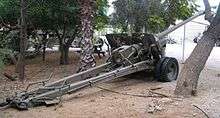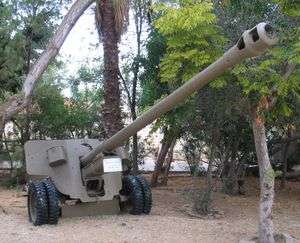100 mm field gun M1944 (BS-3)
| 100 mm field gun model 1944 (BS-3) | |
|---|---|
|
BS-3 at the Israel Defense Forces History Museum, Israel. | |
| Type | Field and anti-tank gun |
| Place of origin | Soviet Union |
| Service history | |
| Used by |
Bulgaria China Cyprus East Germany Egypt Hungary India Latvia Lebanon Liberia[1] Mongolia North Korea North Vietnam Poland Romania Somalia Soviet Union Sudan Vietnam |
| Production history | |
| Produced | 1944–51 |
| Specifications | |
| Weight | 3,650 kg (8,047 lbs) |
| Barrel length |
Bore: 5.34 m (17 ft 6 in) L/53.5 Overall: 5.96 m (19 ft 7 in) L/59.6 (with muzzle brake) |
| Crew | 6 to 8 |
|
| |
| Shell | 100 × 695 mm. R |
| Caliber | 100 mm (3.93 in) |
| Carriage | split trail |
| Elevation | -5° to 45° |
| Traverse | 58° |
| Rate of fire | 8 to 10 rpm |
| Muzzle velocity | 900 m/s (2,953 ft/s) |
| Maximum firing range | 20 km (12.42 mi) |
The 100 mm field gun M1944 (BS-3) (Russian: 100-мм полевая пушка обр. 1944 г. (БС-3)) was a Soviet 100 mm anti-tank and field gun. The gun was successfully employed in the late stages of World War II, and remained in service into the 1950s, being replaced in Soviet service by the T-12 antitank gun and the 85 mm antitank gun D-48 in 1955. The BS-3 was also sold to a number of other countries and in some of these countries the gun is still in service. A number of BS-3 pieces are still stored in Russian Army arsenals. Also at least 12 BS-3 cannons are active in 18th Machinegun & Artillery Division, located on the Kuril Islands, used as anti-ship and anti-landing guns (2012).
History
The BS-3 was based on a B-34 naval gun. The development team was led by V. G. Grabin.
The gun was employed by light artillery brigades of tank armies (20 pieces along with 48 ZiS-3) and by corps artillery.

In the Second World War the BS-3 was successfully used as a powerful anti-tank gun. It was capable of defeating any contemporary tank at long range, excluding the Tiger Ausf B: to destroy that heavy tank the gun needed to shoot at less than 1600 m from the target. The gun was also used as a field gun. Though in this role it was less powerful than the 122 mm A-19, as it fired a smaller round, the BS-3 was more mobile and had a higher rate of fire.
Ammunition data
- Ammunition
- AP: BR-412
- APBC: BR-412B, BR-412D
- HE/Fragmentation
- Projectile weight
- AP/APBC: 15.88 kg (35 lbs)
- HE/Fragmentation: 15.6 kg (34.39 lbs)
- Armor penetration (BR-412B, 30° degrees)
- 500 m : 190 mm
(547 yds : 6.29 in) - 1000 m : 170 mm
(1,093 yds : 6 in)
- 500 m : 190 mm
See also
External links
| Wikimedia Commons has media related to BS-3 100 mm gun. |
- Shunkov V. N. - The Weapons of the Red Army, Mn. Harvest, 1999 (Шунков В. Н. - Оружие Красной Армии. — Мн.: Харвест, 1999.) ISBN 985-433-469-4
- Christopher F. Foss, Artillery of the World
- Armor penetration table

